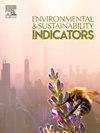Advanced groundwater potential and contamination vulnerability assessment using integrated GIS-based AHP techniques: A case study from the Bizerte watershed, Tunisia
IF 5.4
Q1 ENVIRONMENTAL SCIENCES
引用次数: 0
Abstract
Sustainable management and monitoring of groundwater resources are critical for ensuring their availability for drinking, agriculture, and industry worldwide. In Bizerte, Tunisia (Southwest Mediterranean region), this need is particularly urgent due to rising demand and contamination risks, aligning with Sustainable Development Goal 6 (SDG 6), which seeks to ensure the availability and sustainable management of water and sanitation for all. This research aims to enhance groundwater management and assess contamination risks in Bizerte using the Analytic Hierarchy Process (AHP). A multidisciplinary approach was adopted, integrating multi-criteria analysis and a spatially referenced hydrogeological information system. Eight thematic layers, geomorphology (0.15), slope (0.10), lineament density (0.12), drainage density (0.10), land use/land cover (0.08), precipitation (0.20), lithology (0.15), and soil (0.10) were analyzed for their impact on groundwater availability. Weights were assigned via an AHP-based pairwise comparison matrix and integrated using Geographic Information System (GIS) technology to generate a groundwater potential map. The analysis revealed that approximately 60% of the area has significant groundwater potential, with 30% classified as high potential zones and 30% as moderate potential zones. Vulnerability to contamination was assessed, showing that 20% of the area is at risk, primarily due to agricultural activities, industrial discharges, and inadequate waste management. The results highlighted the need for continuous monitoring and effective management strategies, underscoring the importance of a holistic approach in groundwater management to provide a robust decision-making framework.

求助全文
约1分钟内获得全文
求助全文
来源期刊

Environmental and Sustainability Indicators
Environmental Science-Environmental Science (miscellaneous)
CiteScore
7.80
自引率
2.30%
发文量
49
审稿时长
57 days
 求助内容:
求助内容: 应助结果提醒方式:
应助结果提醒方式:


